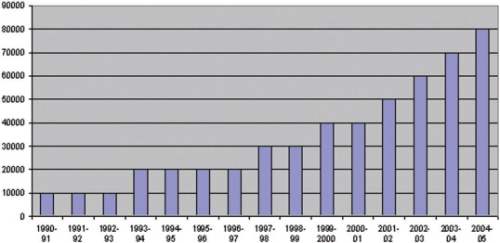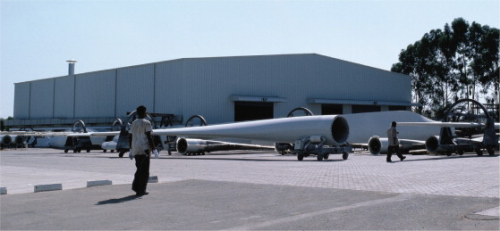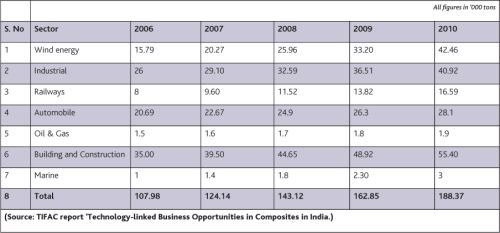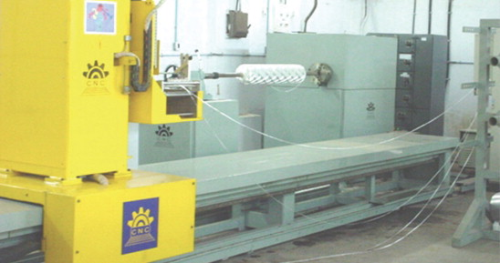





The Indian composites industry has a long history.
In its report 'Technology-linked Business Opportunities in Composites in India,' the Technology Information, Forecasting and Assessment Council (TIFAC), part of the Indian government's Department of Science and Technology, reports that the first use of fibre reinforced plastics (FRP) in India started in 1962 with the manufacture of roofing sheets by Praga Industries, Coimbatore. In 1964, Chemical Process Equipments Pvt Ltd, Mumbai, started fabricating composite tanks for the chemical industry.
Production of polyester resins was first started by Bakelite Hylem Ltd in Hyderabad in 1973. Availability of these essential raw materials triggered the setting up of several small-scale units in India for making composite products using the hand lay-up process. However, the high cost of raw materials, lack of availability of many essential materials (a result of import restrictions) and the lack of mechanised production methods limited the production of composites in large volumes. As a result, the Indian composite industry could not compete with steel, aluminium or timber.
Local support
Core materials supplier DIAB has established a sales office, sheet finishing facility and DIAB Technologies composite engineering team in Chennai, south India. The company's main target markets in the country are wind energy, transportation, and general composites fabrication.
“DIAB was extremely pleased with the reception we received from the local composite market at ICERP," says Craig Jacka, Business Development Manager for DIAB Structural Core Materials, India. "There was a strong desire shown by the local fabricators to adopt manufacturing technology such as resin vacuum infusion and resin transfer moulding. As a result of this interest, we took many inquiries at ICERP from local companies wanting composite engineering and infusion training and support, which we hope to support through our local DIAB Technologies team."
"For DIAB, the exhibition far exceeded our expectations, and again confirmed us of the abundant opportunities in this rapidly growing market.”
During the last three decades, more than 1200 small-scale enterprises have been established in the country. Over 98% of these use the hand lay-up technique for fabricating composite products. Improvements in volume growth only started in early 2000 as a result of the globalisation of the Indian economy.
The total production of composites was about 75 000 tons in 2004-2005, notes TIFAC, and it had risen to 1 10 000 tons in 2005-2006. Figure 1 shows the growth of Indian composite industry from 1990 onwards.
Wind energy
India has made tremendous progress in the wind power sector where composites consumption has exceeded that of China and Japan. India is the fourth largest generator of wind power in the world and Indian company Suzlon Energy Ltd, Pune, has emerged as one of the leading suppliers of wind turbines in the global market.
It is estimated that roughly 100 000 MW of power can be produced in India from only small wind turbines of 10-500 KW capacity.
Chemical equipment
The major use of composites in India began with the chemical industry because of excellent corrosion resistance of composites. Applications in this sector include chemical equipment, piping, and fire fighting breathing apparatus. Composite pipes find applications in sea-water intakes and effluent discharge in desalination plants, as ducts in the chemical industry, as cross-country water transmission pipelines, sewer pipelines etc. Composites are also being used for fabricating cooling tower units where the composite materials resist the corrosive effects of moisture.
Aircraft market
Evonik Degussa India is a wholly owned subsidiary of Evonik Industries. Evonik Röhm GmbH's Performance Polymers Business Unit produces the ROHACELL®a series of polymethacrylimide (PMI) foams which are used as a structural core material for sandwich constructions.
Since April 2007, Evonik Degussa India's Performance Polymer Business unit has been directly involved in developing the markets for ROHACELL in India, such as, for example, aerospace, medical and telecommunications. In 2007, significant sales growth was realised, mainly boosted by aircraft application. Currently the most prominent application of PMI foam is the Indian Advanced Light Helicopter where it is used as structural sandwich core for the rotor blades. ROHACELL is also finding emerging market share for applications like radomes and antenna constructions for telecommunication, medical – x-ray or CT scan tables, hi-fi loudspeakers, sandwich bonnet in the automotive industry, rail vehicles, shipbuilding and sports applications.
Rail
Composites were identified as a potential material for application in the Indian Railways in the early 1980s for many passenger coach components such as louvre and glass shutters, window sills and frames, trays for battery boxes, ceilings, and flooring. The railways were working towards the complete elimination of timber and plywood in the coaches.
The present consumption of composite materials by Indian Railways is estimated at about 8000 tons, with an annual growth rate of 20%.
Automotive
The automobile industry is another sector where significant amounts of composite materials have been used in passenger cars, scooters and helmets.
The growth rate of composites used in the automotive sector is shown in Table 2 above.
Oil and gas
There are a vast number of potential applications for composites in the oil and gas sector in India over the coming years in high-pressure pipes and pipe fittings. Current offshore structural applications of composites include low-pressure pipe, gratings, handrails, equipment covers or enclosures and ladders. Because of their low weight, corrosion resistance, improved life-cycle costs and enhanced safety, it is predicted that composite materials can capture 50% of this market in the oil and gas sector in the next 5-6 years.
Marine
The use of composites for boat building applications started in early 1970s for replacing wood because of the advantages of corrosion resistance, ease of fabrication, improved performance and low cost. The marine market for composites stood at around 1000 tons per year in 2006 and this is expected to grow to 3000 tons by 2010. Applications include leisure boats, houseboats, and speedboats.
The Indian composite industry made a humble beginning over four decades ago with the applications mostly limited to the chemical industry for corrosion resistance. The absence of advanced fabrication techniques coupled with application-oriented R&D and also lack of preparedness of the user community to introduce the material have been some of the hindrances for a rapid growth of Indian composites industry. In view of the importance of composites as a performance material with huge application, potential especially for a country like India, the Composite Applications Laboratory (CAL) has been set up under the aegis of the Department of Chemical Engineering, Indian Institute of Technology (IIT)-Kharagpur. CAL has been conceptualised as an industry-focused and industry-oriented centre of excellence to extend technology support in composite product design and fabrication along with process optimisation, QA & QC requirements etc. The project is an important step for India where the technology support for composites has been inadequate. Another important aspect of CAL activities is developing appropriate human resources by taking up advanced research, offering courses in composites to B.Tech & M.Tech students, and conducting modular training programmes in composite product design and fabrication for the Indian composite industry. A 5-credit course on ‘Manufacturing & Characterisation of Polymer matrix composites’ is being offered to final year B.Tech and first year M.Tech students in the semester commencing in January each year. This is an inter-disciplinary programme for students from departments of chemical, aerospace, material science and mechanical engineering. The students are also encouraged to take up live industrial problems in innovative composite manufacturing technology as projects as part of their curriculum in the final year. The dedicated CAL team comprises of multidisciplinary group of faculty members from Chemical, Mechanical and Aerospace Engineering departments. The state-of-the-art manufacturing and testing facilities have been established to meet the needs of industry. Modern fabrication techniques available in the Composite Application Laboratory at IIT include 6-axes filament winding system complete with 60 tons hydraulic extractor unit and CADWIND software, resin transfer moulding (RTM) and vacuum assisted resin transfer moulding (VARTM) equipments along with gel-coat sprayer and 300-ton compression moulding system. The testing and characterisation laboratory for composites at CAL has been equipped for raw material characterisation with a Bohlin viscometer, curing study system, mechanical testing for reinforcement. Other equipment for mechanical characterisation and flaw detection of the finished composite product include UTM, impact tester, fatigue tester, Barcol hardness tester and NDT scanner. CAL also has a limited oxygen index tester, equipment for fire spread ability, smoke density and toxicity for comprehensive evaluation of fire and toxicity performance of the composite product. Several commercial software packages including ANSYS and PAM RTM are available for performance analysis of the finished composite product and virtual simulation of the composite manufacturing process. The core services being offered by CAL at IIT include carrying out a few high-end research projects sponsored by industry, using the equipment for prototype development by industry, product and process design support for composites, conducting summer/winter 'schools' for catering to urgent training needs of the composite industry. IIT also plans to initiate activities concerning development of thermoplastic-biomass (filler) composites and long fibre (glass)-thermoplastic composites. IIT has archives of handbooks, publications and standards on composite design, fabrication and testing. The list will soon be available online on the CAL website. The Composite Applications Laboratory opened its doors on 15 February 2008 when it was inaugurated by Dr R. Chidambaram, Principal Scientific Adviser to Govt. of India and Chairman-TIFAC. |
Growing fast
The Indian composites market has been growing rapidly and modern technology is gradually being introduced. An analysis of the market reveals that although many small fabricators are using hand lay-up methods for manufacturing composite products, the use of computer controlled, advanced fabrication techniques such as filament winding, pultrusion and resin transfer moulding (RTM) is growing rapidly, reports TIFAC. There is a huge potential for use of composites in the Indian automobile industry, especially for catering to the transportation needs of growing middle-class population. There would be a good market for hoods, cabs, frames, and cargo containers that could be used as part of these locally-built vehicles. Other opportunities for the Indian composites industry include refrigerated freight containers, pressure vessels, fishing boats, walkways and piles for building foundations, and air intake manifolds.




